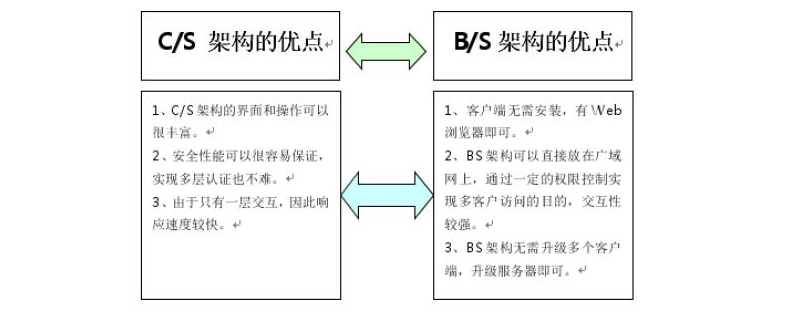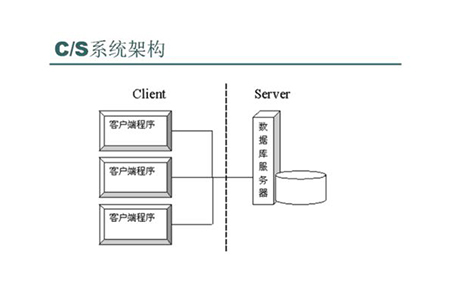 Backend Development
Backend Development
 PHP Tutorial
PHP Tutorial
 What is the difference between B/S architecture and C/S architecture?
What is the difference between B/S architecture and C/S architecture?
What is the difference between B/S architecture and C/S architecture?
The differences between B/S architecture and C/S architecture are: B/S architecture has low computer configuration requirements while C/S has high requirements. B/S does not require installation and maintenance, while C/S does. B/S The security performance is low and C/S is high. B/S has relatively good software reuse but C/S does not.
B/S architecture and C/S architecture are two commonly used client server structures. Next In this article, we will introduce the differences between these two architectures in detail, which will serve as a reference and I hope it will be helpful to you.

[Recommended course: PHP Tutorial]
B/S Architecture
The B/S architecture is a browser/server architecture. The browser refers to the web browser that mainly processes a small number of business logic, and the main role of the server is to process business logic. It is composed of a three-tier architecture. It is simple to use and can run directly in a web browser without installation. The client in this architecture contains very little logic

C/S architecture
C/S architecture is a typical two-tier architecture. The whole process is Client/Server, client-server architecture. The client contains one or more servers running on the user. In terms of computer programs, there are two servers: database server and Socket server. The database server mainly connects the client to the server-side data through the database, and the Socket server is used to communicate with the client. In this structure, the client needs to implement business logic and interface to display the most

The difference between B/S architecture and C/S architecture
(1) Client requirements
B/S has low computer configuration requirements, while C/S has high computer configuration requirements
(2) Software installation and maintenance
B/S does not need to install any software or maintain; C/S must install and configure special software and also needs to upgrade and maintain
(3) Security
B/S is built on the WAN, has relatively weak security control capabilities, and is oriented to an unknown user group
C/S is general For a relatively fixed user group, it can perform multi-level verification of permissions, provide a more secure access mode, and has strong control over information security
(4) Software Reusing multiple structures of different
B/S pairs requires relatively independent functions of the components. Relatively good reuse of
C/S programs can inevitably be considered holistically, The reusability of components is not as good as that under B/S requirements.
The above is the detailed content of What is the difference between B/S architecture and C/S architecture?. For more information, please follow other related articles on the PHP Chinese website!

Hot AI Tools

Undresser.AI Undress
AI-powered app for creating realistic nude photos

AI Clothes Remover
Online AI tool for removing clothes from photos.

Undress AI Tool
Undress images for free

Clothoff.io
AI clothes remover

AI Hentai Generator
Generate AI Hentai for free.

Hot Article

Hot Tools

Notepad++7.3.1
Easy-to-use and free code editor

SublimeText3 Chinese version
Chinese version, very easy to use

Zend Studio 13.0.1
Powerful PHP integrated development environment

Dreamweaver CS6
Visual web development tools

SublimeText3 Mac version
God-level code editing software (SublimeText3)

Hot Topics
 1377
1377
 52
52
 cURL in PHP: How to Use the PHP cURL Extension in REST APIs
Mar 14, 2025 am 11:42 AM
cURL in PHP: How to Use the PHP cURL Extension in REST APIs
Mar 14, 2025 am 11:42 AM
The PHP Client URL (cURL) extension is a powerful tool for developers, enabling seamless interaction with remote servers and REST APIs. By leveraging libcurl, a well-respected multi-protocol file transfer library, PHP cURL facilitates efficient execution of various network protocols, including HTTP, HTTPS, and FTP. This extension offers granular control over HTTP requests, supports multiple concurrent operations, and provides built-in security features.
 Alipay PHP SDK transfer error: How to solve the problem of 'Cannot declare class SignData'?
Apr 01, 2025 am 07:21 AM
Alipay PHP SDK transfer error: How to solve the problem of 'Cannot declare class SignData'?
Apr 01, 2025 am 07:21 AM
Alipay PHP...
 12 Best PHP Chat Scripts on CodeCanyon
Mar 13, 2025 pm 12:08 PM
12 Best PHP Chat Scripts on CodeCanyon
Mar 13, 2025 pm 12:08 PM
Do you want to provide real-time, instant solutions to your customers' most pressing problems? Live chat lets you have real-time conversations with customers and resolve their problems instantly. It allows you to provide faster service to your custom
 Explain the concept of late static binding in PHP.
Mar 21, 2025 pm 01:33 PM
Explain the concept of late static binding in PHP.
Mar 21, 2025 pm 01:33 PM
Article discusses late static binding (LSB) in PHP, introduced in PHP 5.3, allowing runtime resolution of static method calls for more flexible inheritance.Main issue: LSB vs. traditional polymorphism; LSB's practical applications and potential perfo
 Explain JSON Web Tokens (JWT) and their use case in PHP APIs.
Apr 05, 2025 am 12:04 AM
Explain JSON Web Tokens (JWT) and their use case in PHP APIs.
Apr 05, 2025 am 12:04 AM
JWT is an open standard based on JSON, used to securely transmit information between parties, mainly for identity authentication and information exchange. 1. JWT consists of three parts: Header, Payload and Signature. 2. The working principle of JWT includes three steps: generating JWT, verifying JWT and parsing Payload. 3. When using JWT for authentication in PHP, JWT can be generated and verified, and user role and permission information can be included in advanced usage. 4. Common errors include signature verification failure, token expiration, and payload oversized. Debugging skills include using debugging tools and logging. 5. Performance optimization and best practices include using appropriate signature algorithms, setting validity periods reasonably,
 Framework Security Features: Protecting against vulnerabilities.
Mar 28, 2025 pm 05:11 PM
Framework Security Features: Protecting against vulnerabilities.
Mar 28, 2025 pm 05:11 PM
Article discusses essential security features in frameworks to protect against vulnerabilities, including input validation, authentication, and regular updates.
 Customizing/Extending Frameworks: How to add custom functionality.
Mar 28, 2025 pm 05:12 PM
Customizing/Extending Frameworks: How to add custom functionality.
Mar 28, 2025 pm 05:12 PM
The article discusses adding custom functionality to frameworks, focusing on understanding architecture, identifying extension points, and best practices for integration and debugging.
 How to send a POST request containing JSON data using PHP's cURL library?
Apr 01, 2025 pm 03:12 PM
How to send a POST request containing JSON data using PHP's cURL library?
Apr 01, 2025 pm 03:12 PM
Sending JSON data using PHP's cURL library In PHP development, it is often necessary to interact with external APIs. One of the common ways is to use cURL library to send POST�...



